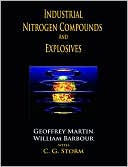

 |

|

The average rating for Industrial Nitrogen Compounds And Explosives based on 2 reviews is 3 stars.
Review # 1 was written on 2010-12-05 00:00:00 Tracey Young Tracey YoungThis book takes an interesting but frustrating approach to teaching computational quantum chemistry. It does a reasonably good job of attempting to teach the basics of quantum mechanics, as well as the most important computational methods, in a limited amount of space. Most beginning courses on quantum chemistry dwell long enough on the harmonic oscillator and hydrogen atom that they have little time for the details of ab initio calcualtions. Most applied courses on computational chemistry, on the other hand, are forced to assume the student is already familiar with undergraduate-level quantum mechanics. This book attempts to have its cake and eat it, too, with a quick tour through the basics of theoretical quantum mechanics before spending an equal amount of time on computational methods. There are other books that cover both theoretical and methodological topics, with the best being Levine's Quantum Chemistry. But this is one of few such books that seem to be realistically aiming to cover everything in a single semester. The reality, however, is that this is too much information to digest in a single semester. If it is truly necessary to cover all of computational quantum chemistry in a single semester, this text provides a good compromise; but generally it would be better to cover the topics more slowly, so they can be learned well. One thing that sets the book apart is its heavy focus on applications. The last half of the book is devoted to specific applications designed to illustrate various types of ab initio calculations: from basics such as structure, energetics and vibrational frequencies to more advanced calculations including transition states, excited states, and ab initio molecular dynamics. It is not difficult to imagine using these as the basis for a series of exercises or lab assignments. Unfortunately, these sections have little instructional value. After a brief overview of the theory behind the calculations, the results are described as if the reader is actually concerned with the vibrational frequencies of perfluorocyclopropene (for example), rather than spending any time on practical considerations such as the rationale behind vibrational frequency scaling factors or the choices that must be made in performing real-world calculations. In this latter half of the book the authors seem to begin writing for an audience of researchers, rather than students. Consequently, this part of the book, while well intentioned, is neither as instructive nor as interesting as it should have been. A book which does a better job of using applications to actually teach how the calculations should be done is Lewars' Computational Chemistry. |
Review # 2 was written on 2018-06-15 00:00:00 Cipta Hardi Cipta HardiI love this book. I have read this from cover to cover for three times! This helped me lot for my board exams. Since I am an Asian, I get to understand this easily. The words and sentences can be easily understood for everyone especially for Asians like me. Kudos to Raymond Chang! |
CAN'T FIND WHAT YOU'RE LOOKING FOR? CLICK HERE!!!